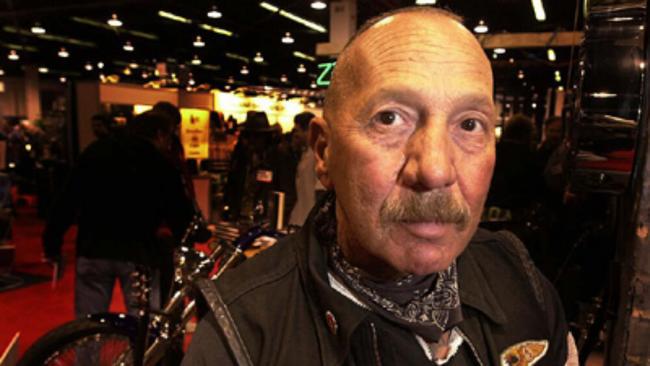Sonny Barger founded the Hells Angels in a long life of crime
Sonny Barger was 16 when he forged a birth certificate and joined the army. On the discovery of his real age, he was honourably discharged — perhaps his last honourable act.

OBITUARY
Ralph Hubert “Sonny” Barger
Hells Angel founder. Born Modesto, California, October 8, 1938. Died June 29, aged 83.
Had the Japanese not bombed Pearl Harbor, America’s outlaw motorcycle gangs might never have formed.
With their state’s long Pacific coast, Californians felt vulnerable after the surprise attack in Hawaii that killed 2500 Americans. So many Californians signed on to fight that by war’s end more than 800,000 had served in the military.
Eager recruits from across the country came to California to train, while shipbuilders and aircraft factories employed thousands for the war effort. About 500,000 Americans moved to the state as the wartime economy boomed. But 1945 brought peace and bust.
By 1946, California’s jobless rate was almost 9 per cent; for the rest of the country it was 3 per cent. Young veterans missing the camaraderie, excitement and danger of military life began to form loose groups riding Harley-Davidson bikes. It was seen as being patriotic; the company had supplied Harleys to the army and navy during the war.
Sonny Barger was 16 when he forged a birth certificate and joined the army in 1955. On the discovery of his real age, he was honourably discharged – perhaps his last honourable act.
While floating between unskilled jobs he began associating with riders who, perhaps inspired by the Marlon Brando character in The Wild One (1953), wore leather jackets and celebrated being anti-social. That film was based on the events of July 4, 1947, when an American Motorcycle Association rally ended in riotous violence. The association later said 99 per cent of rally riders were civilised.
Taking the tag “One Percenters”, Barger, a narcissistic, drug-abusing thug inclined, like his weekend friends, to sudden, unprovoked violence, formed the Hells Angels on April Fools' Day in 1957.
Barger rode about southern California subsuming small clubs and building a motorcycle mafia with armylike rules and discipline – and even a uniform. Most Hells Angels’ suffered from a cluster of incurable vices and unquenched internal furies that manifested themselves in sadism, random cruelty and the enslavement of women
It wasn’t long before Barger was racking up a criminal record for drug use and assault. The Hells Angels were hedonistic, but mostly unemployable hoods; drug dealing came naturally. It still does. It moved from marijuana to methamphetamine and soon heroin. Barger would accumulate charges for attempted murder, unlawful imprisonment, kidnap, arson, racketeering and illegal possession of firearms, narcotics and explosives.
He often avoided conviction. It may not be a coincidence that for years he had a curious relationship with California police, acting as an informant against left-wing groups such as the Weather Underground, revealing the whereabouts of these gangs’ gun caches – the suggestion was Barger had peddled or perhaps planted the weapons – in exchange for the release of jailed Hells Angels. Barger pushed this relationship further, suggesting to police in 1971 a deal whereby a Hells Angel be released for every body of a Weatherman he delivered.
By then Hunter S. Thompson, and Tom Wolfe in his book The Electric Kool-Aid Acid Test, had reported on Barger, and he was a paid adviser to films about motorcycle gangs, even acting in one. But his most famous screen appearance was as leader of the Hells Angels gang providing “security” to the Rolling Stones at the notorious Altamont concert in December 1969 at which they stabbed to death 18-year-old Meredith Hunter. This drama was caught on film in the documentary Gimme Shelter. The Hells Angels were paid in beer – by today’s value, about $5000 worth – and as they became drunk and more violent, they lashed out at crowd members and artists alike.
As things fell apart during the Stones’ set, a drug-affected woman forced her way through Barger’s thugs and to the stage. Keith Richards approached Barger: “Man, I’m sure it doesn’t take three or four great big Hells Angels to get that bird off the stage.” Barger took it as a slight on his manliness and kicked the woman in the head. Richards said the band would not play on. “I stood next to him and stuck my pistol into his side and told him to start playing his guitar or he was dead,” Barger wrote later.
He came out of prison – again – in 1992 and held a party when his parole ran out in 1994. A US senator and House of Representatives member attended.
American professor of criminology Gregg Etter, who has studied the motorcycle gangs for years, concludes that to be “a member of such a deviant subculture takes a special type of person, one who revels in its abnormalities. The members of the outlaw biker subculture largely have one thing in common: some form of mental defect.”




To join the conversation, please log in. Don't have an account? Register
Join the conversation, you are commenting as Logout